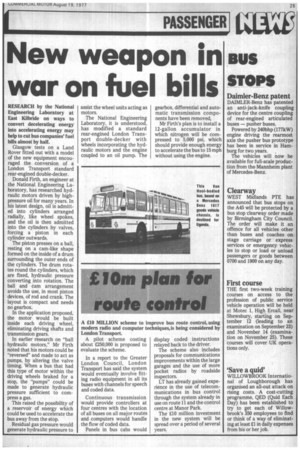New weapon in war on fuel bills
Page 27

If you've noticed an error in this article please click here to report it so we can fix it.
RESEARCH by the National Engineering Laboratory at East Kilbride on ways to convert decelerating energy into accelerating energy may help to cut bus companies' fuel bills almost by half.
Glasgow tests on a Land Rover fitted out with a model of the new equipment encouraged the conversion of a London Transport standard rear-engined double-decker.
Donald Firth, an engineer at the National Engineering La boratory, has researched hyd raulic motors driven by highpressure oil for many years. In his latest design, oil is admitt ed into cylinders arranged radially, like wheel spokes, and the oil is then admitted into the cylinders by valves, forcing a piston in each cylinder outwards.
The piston presses on a ball, resting on a cam-like shape formed on the inside of a drum surrounding the outer ends of the cylinders. The drum rota tes round the cylinders, which are fixed, hydraulic pressure converting into rotation. The ball and cam arrangement avoids the use, in most piston devices, of rod and crank. The layout is compact and needs no gearbox.
In the application proposed, the motor would be built inside each driving wheel, eliminating driving shafts and transmission gears.
In earlier research on "ball hydraulic motors," Mr Firth noted that his motors could be "reversed" and made to act as pumps, by altering the valve timing. When a bus that had this type of motor within the driving wheels braked for a stop, the "pumps" could be made to generate hydraulic pressure sufficient to compress a gas.
This raised the possibility of a reservoir of energy which could be used to accelerate the bus away from the stop.
Residual gas pressure would generate hydraulic pressure to assist the wheel units acting as motors.
The National Engineering Laboratory, it is understood, has modified a standard rear-engined London Transport double-decker with wheels incorporating the hydraulic motors and the engine coupled to an oil pump. The gearbox, differential and automatic transmission components have been removed, Mr Firth's plan is to install a 12-gallon accumulator in which nitrogen will be compressed to 5,000 psi, which should provide enough energy to accelerate the bus to 15 mph without using the engine.




































































































